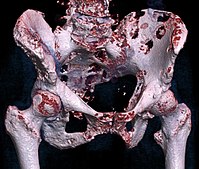
Photo from wikipedia
Spinal bone metastases from uterine leiomyosarcoma (LMS) are relatively uncommon and few data are present in the literature. In this study, cases of nine consecutive patients who underwent spinal surgery… Click to show full abstract
Spinal bone metastases from uterine leiomyosarcoma (LMS) are relatively uncommon and few data are present in the literature. In this study, cases of nine consecutive patients who underwent spinal surgery for metastatic uterine LMS between 2012 and 2022 at a single institution were retrospectively reviewed. The recorded demographic, operative, and postoperative factors were reviewed, and the functional outcomes were determined by changes in Frankel grade classification during follow-up. A systematic review of the literature was also performed to evaluate operative and postoperative factors and outcomes for patients with the same gynecological metastases to the spine. For our cases, the mean time between primary tumors to bone metastases diagnosis was 5.2 years, and the thoracic vertebrae were the most affected segment. Overall, median survival after diagnosis of metastatic spine lesions was 46 months. For the systematic review, the mean time between primary tumors to bone metastases was 4.9 years, with the lumbar spine as the most involved site of metastasis. Overall, median survival after diagnosis was 102 months. Once a spinal bone lesion from LMS is identified, surgical treatment can be beneficial and successful in alleviating symptoms. Further efforts will be crucial to identify prognostic markers as well as therapeutic targets to improve survival in these patients.
Journal Title: Diagnostics
Year Published: 2022
Link to full text (if available)
Share on Social Media: Sign Up to like & get
recommendations!